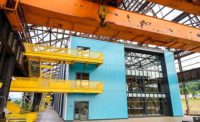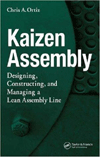On Campus: Robots Rule at Carnegie Mellon
The National Robotics Engineering Center works on a wide variety of real-world projects for both military and commercial customers.
Most university–run research labs are often littered with empty pizza boxes and cans of Red Bull. But, that’s not the case at the National Robotics Engineering Center (NREC) at Carnegie Mellon University (CMU). The 15-year-old facility is a fully functioning R&D center that works on a wide variety of real-world projects for both military and commercial customers.
At any given time, CMU students and researchers are engaged in projects that focus on mobile robotic applications for clients such as the U.S. Army, the U.S. Marine Corps, NASA, Caterpillar, Deere and Shell Oil Co. The NREC, a key part of CMU’s Robotics Institute, is housed in a century-old foundry along the banks of the Allegheny River, a 10-minute drive from CMU’s Pittsburgh campus.
Sponsored research at the 110,000-square-foot robotics center has grown from $17 million in 2005 to $25 million in 2010. The 150-person engineering staff is at the forefront of unmanned ground vehicle design; off-road autonomy; sensing and perception; machine vision; and machine learning. Recent real-world applications include agriculture, mining, and oil and gas exploration.
“We combine the strengths of a great research university-innovative culture, access to great talent and groundbreaking research-with many of the characteristics found in an engineering services company,” says Steve DiAntonio, business development director. “The combination gives our sponsors the ability to rapidly and cost-effectively assess the commercialization potential of robotics technology for their markets and applications.”
The NREC recently landed a $1.5 million dollar contract from the U.S. Army Corps of Engineers to develop a semiautonomous robot to clear metal debris and vegetation from artillery ranges. A modified, unmanned commercial excavator will use a powerful, magnetized scouring implement to safely sweep plants, pieces of ferrous metal and unexploded ordnance into piles, preparing the area for remediation and eventual reuse.
Another good example of NREC’s ingenuity is the Unmanned Ground Combat Vehicle Perceptor Integration (UPI) program. “It dramatically advances the state-of-the-art in two distinct areas: unmanned vehicle design and off-road autonomy,” claims DiAntonio. “UPI vehicle design will impact military vehicle design well into the future, and the autonomy software will be applied in many outdoor mobile robot applications.”
An average of 30 to 40 patents are issued to NREC engineers annually. And, last year, it spun off a company called Carnegie Robotics LLC to develop, manufacture and service robotic components and systems. Carnegie Robotics will create products based upon technology licensed from NREC.
Several months ago, the NREC made headlines when President Barack Obama visited and launched the Advanced Manufacturing Partnership. Among other things, it calls for $70 million in federal funds to support research into robots that “will work closely with human operators, allowing new ability for factory workers…to carry out key, hard-to-do tasks.”
This initiative will be a major focus of NREC during the next few years. “We’ve hired several new faculty with strong research credentials in perception, machine learning, and manipulation design and planning,” says DiAntonio.
“They will be tackling tough manufacturing challenges, such as humans working closely and cooperatively with manipulator arms, thereby reducing standoff distance and fixturing costs,” DiAntonio points out. “[Other efforts will focus on] dramatically reducing manipulator set-up time so that rapidly changing and lower volume product runs can be more effectively automated, [in addition to] reducing the need for manipulator precision through effective application of machine vision.”
Most university–run research labs are often littered with empty pizza boxes and cans of Red Bull. But, that’s not the case at the National Robotics Engineering Center (NREC) at Carnegie Mellon University (CMU). The 15-year-old facility is a fully functioning R&D center that works on a wide variety of real-world projects for both military and commercial customers.
At any given time, CMU students and researchers are engaged in projects that focus on mobile robotic applications for clients such as the U.S. Army, the U.S. Marine Corps, NASA, Caterpillar, Deere and Shell Oil Co. The NREC, a key part of CMU’s Robotics Institute, is housed in a century-old foundry along the banks of the Allegheny River, a 10-minute drive from CMU’s Pittsburgh campus.
Sponsored research at the 110,000-square-foot robotics center has grown from $17 million in 2005 to $25 million in 2010. The 150-person engineering staff is at the forefront of unmanned ground vehicle design; off-road autonomy; sensing and perception; machine vision; and machine learning. Recent real-world applications include agriculture, mining, and oil and gas exploration.
“We combine the strengths of a great research university-innovative culture, access to great talent and groundbreaking research-with many of the characteristics found in an engineering services company,” says Steve DiAntonio, business development director. “The combination gives our sponsors the ability to rapidly and cost-effectively assess the commercialization potential of robotics technology for their markets and applications.”
The NREC recently landed a $1.5 million dollar contract from the U.S. Army Corps of Engineers to develop a semiautonomous robot to clear metal debris and vegetation from artillery ranges. A modified, unmanned commercial excavator will use a powerful, magnetized scouring implement to safely sweep plants, pieces of ferrous metal and unexploded ordnance into piles, preparing the area for remediation and eventual reuse.
Another good example of NREC’s ingenuity is the Unmanned Ground Combat Vehicle Perceptor Integration (UPI) program. “It dramatically advances the state-of-the-art in two distinct areas: unmanned vehicle design and off-road autonomy,” claims DiAntonio. “UPI vehicle design will impact military vehicle design well into the future, and the autonomy software will be applied in many outdoor mobile robot applications.”
An average of 30 to 40 patents are issued to NREC engineers annually. And, last year, it spun off a company called Carnegie Robotics LLC to develop, manufacture and service robotic components and systems. Carnegie Robotics will create products based upon technology licensed from NREC.
Several months ago, the NREC made headlines when President Barack Obama visited and launched the Advanced Manufacturing Partnership. Among other things, it calls for $70 million in federal funds to support research into robots that “will work closely with human operators, allowing new ability for factory workers…to carry out key, hard-to-do tasks.”
This initiative will be a major focus of NREC during the next few years. “We’ve hired several new faculty with strong research credentials in perception, machine learning, and manipulation design and planning,” says DiAntonio.
“They will be tackling tough manufacturing challenges, such as humans working closely and cooperatively with manipulator arms, thereby reducing standoff distance and fixturing costs,” DiAntonio points out. “[Other efforts will focus on] dramatically reducing manipulator set-up time so that rapidly changing and lower volume product runs can be more effectively automated, [in addition to] reducing the need for manipulator precision through effective application of machine vision.”
Looking for a reprint of this article?
From high-res PDFs to custom plaques, order your copy today!







